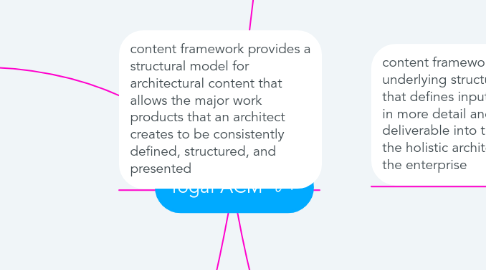
1. Repository
1.1. Content Meta model
1.2. Ref library
1.2.1. Ref architectures
1.2.2. Ref models
1.2.3. Templates
1.2.4. Viewpoint library
1.3. Arch landscape
1.3.1. strategic archtitecture
1.3.2. Segment arrcitecture
1.3.3. capability architecture
1.4. Arch capability
1.5. Governance log
1.5.1. Decision log
1.5.1.1. Justification for arch features of projects
1.5.1.2. Product selections
1.5.1.3. Changes to standards
1.5.1.4. Deviations from standards
1.5.1.5. Change request approvals
1.5.1.6. Re-use assessments
1.5.2. Compliance assessment
1.5.2.1. Project overview and progress
1.5.2.2. Arch checklists
1.5.2.3. Complance to standards
1.5.2.4. Corrective/recommended actions
1.5.3. Capability assessments
1.5.4. Calendar
1.5.5. Project portfolio
1.5.5.1. Arch scope of prject
1.5.5.2. ARch roles and resp. associated with project
1.5.6. Perofmrance measuremetn
1.6. Standards information base
1.6.1. Types
1.6.1.1. Regulatory
1.6.1.2. Industry specific
1.6.1.3. Org specific
1.6.2. Categories
1.6.2.1. Busienss
1.6.2.2. App
1.6.2.3. Data
1.6.2.4. Technology
1.7. Other enterpris repositry
1.7.1. Requeirements repository
1.7.2. Solutions repostory
2. content framework provides a structural model for architectural content that allows the major work products that an architect creates to be consistently defined, structured, and presented
3. output of projects and those deliverables that are in documentation form will typically be archived at completion of a project, or transitioned into an Architecture Repository as a reference model, standard, or snapshot of the Architecture Landscape
4. architectural work product that describes an aspect of the architecture Artifacts are generally classified as catalogs (lists of things), matrices (showing relationships between things), and diagrams (pictures of things)
5. Building block
5.1. Architecture building blocks (ABB)
5.2. Solution building blocks (SBB)
6. (potentially re-usable) component of enterprise capability that can be combined with other building blocks to deliver architectures and solutions
7. Artefacts and views (by ADM phase)
7.1. Prelim/Vision
7.1.1. Principles catalog
7.1.2. Stakeholder map
7.1.3. Value Chain diagram
7.2. Business
7.2.1. Motivation
7.2.1.1. Driver goal objective catalog
7.2.1.2. Contracts/measures catalog
7.2.1.3. Goal-objective-service
7.2.2. People
7.2.2.1. Org/actor catalog
7.2.2.2. Actor-org diagram/matrix
7.2.2.3. role catalog
7.2.2.4. Role allocation
7.2.2.5. Location catalog
7.2.2.6. Location organization
7.2.3. Function
7.2.3.1. Business service/functoin catalog
7.2.3.2. Functional decomposition
7.2.3.3. Business footprint diagram
7.2.3.4. Business interaction matrix
7.2.4. Process
7.2.4.1. Process/event/control/product catalog
7.2.4.2. Process flow
7.2.4.3. Business use case diagram
7.2.4.4. Service-information diagram
7.2.5. Information
7.2.5.1. Data dictoinary
7.2.5.2. Cocneptual data diagram
7.2.5.3. Product lifecycle diagram
7.3. IS
7.3.1. App
7.3.1.1. CAtalogs
7.3.1.1.1. App portfolio catalog
7.3.1.1.2. Interface catalog
7.3.1.2. Matrices/ traceability
7.3.1.2.1. App -user-location diagram
7.3.1.2.2. App-organiztion matrix
7.3.1.2.3. Process-system realization
7.3.1.3. Core diagrams
7.3.1.3.1. App communication diagrams
7.3.1.3.2. App use case
7.3.1.4. Extensions
7.3.1.4.1. App migration diagram
7.3.1.4.2. Enterprise manageability diagram
7.3.2. Data
7.3.2.1. Data entity (conceptual)/data component (logical) catalog
7.3.2.2. Data Modeling
7.3.2.2.1. Logical data diagram
7.3.2.2.2. Service data diagram
7.3.2.3. Matrices/ traceability
7.3.2.3.1. Data dissemination diagram
7.3.2.3.2. Data entity- function matrix
7.3.2.3.3. App- data matrix
7.3.2.4. Extensions
7.3.2.4.1. Data security diagram
7.3.2.4.2. Data migration diagram/matrix
7.4. Technology
7.4.1. Catalogs
7.4.1.1. Tech standards
7.4.1.2. Tech portfolio
7.4.2. Matrices
7.4.2.1. App - Tech
7.4.3. Diagrams
7.4.3.1. Env and location diagram
7.4.3.2. Network computing hardware diagram
7.4.3.3. Platform decomposition diagrma
7.4.3.4. Processing diagram
7.4.3.4.1. Installtion
7.4.3.4.2. Executon
7.4.3.4.3. Persistence data
7.4.3.5. Communication engiineeing diagram
7.5. Opp/solutions/migrations/Requireents
7.5.1. Project context diagram
7.5.2. Benefits diagram
7.5.3. Requiremets catalog
8. Deliverable
8.1. Prelim
8.1.1. Princicples
8.1.2. Goals and drivers
8.2. Vision
8.2.1. Vision
8.2.1.1. Problem descriptioon
8.2.1.2. Objective of SOW
8.2.1.3. Summary views for baseline and target architectures- Solution concept
8.2.2. Capability assessment
8.2.2.1. Business capability -baeline and target
8.2.2.2. IT function
8.2.2.3. Arch function
8.2.3. tailored EA framework
8.2.3.1. Tailored EA method
8.2.3.2. Tailored content
8.2.3.3. Tool
8.2.3.4. Interface/integration with other mgmt. framewworks
8.3. Arch dev
8.3.1. Arch definition
8.3.1.1. Baseline and target architectures- 4 domains
8.3.1.2. Gap analysis
8.3.1.3. Rationale and justification
8.3.1.4. Transitin architectures- 4 domains
8.3.2. Architecture requriementts
8.3.2.1. Rquiemetns and success criteria
8.3.2.1.1. Functional
8.3.2.1.2. Interoperability
8.3.2.1.3. IT service
8.3.2.2. Business and app service contracts
8.3.2.3. Implementation guidelines/specs/stds
8.3.3. REquirmnts impact assessment
8.3.3.1. REf to specific arch req
8.3.3.2. Priority of reqa
8.3.3.3. ADM phase to be revisited
8.4. Migration
8.4.1. Roadmap
8.4.1.1. Work package portfolio
8.4.1.2. Implementation factor/deduction matrix
8.4.1.3. Consolidated gaps,solution and dependency matrix
8.4.1.4. Transition architectures
8.4.2. Implementation/migration plan
8.4.2.1. Migrtion strategy
8.4.2.2. Project /portfolio breakdown
8.4.2.3. Project charters
8.5. Governance
8.5.1. (Arch) Change request
8.5.2. Comms plan
8.5.3. Complaince assessment
8.5.4. Implementatin governance model
8.5.4.1. Processes
8.5.4.2. Org structure
8.5.4.3. Roles and resp
8.5.4.4. Checkpoints and success crteria
8.5.5. EA Org model
8.5.5.1. Scope in terms of partitions
8.5.5.2. Maturity and gaps
8.5.5.3. Roles and resp
8.5.5.4. Constraints for EA work
8.5.5.5. Budget and financials
8.5.5.6. Governance and support
8.6. Contractual
8.6.1. Rquest for EA work
8.6.2. Contracts
8.6.3. State of EA work

